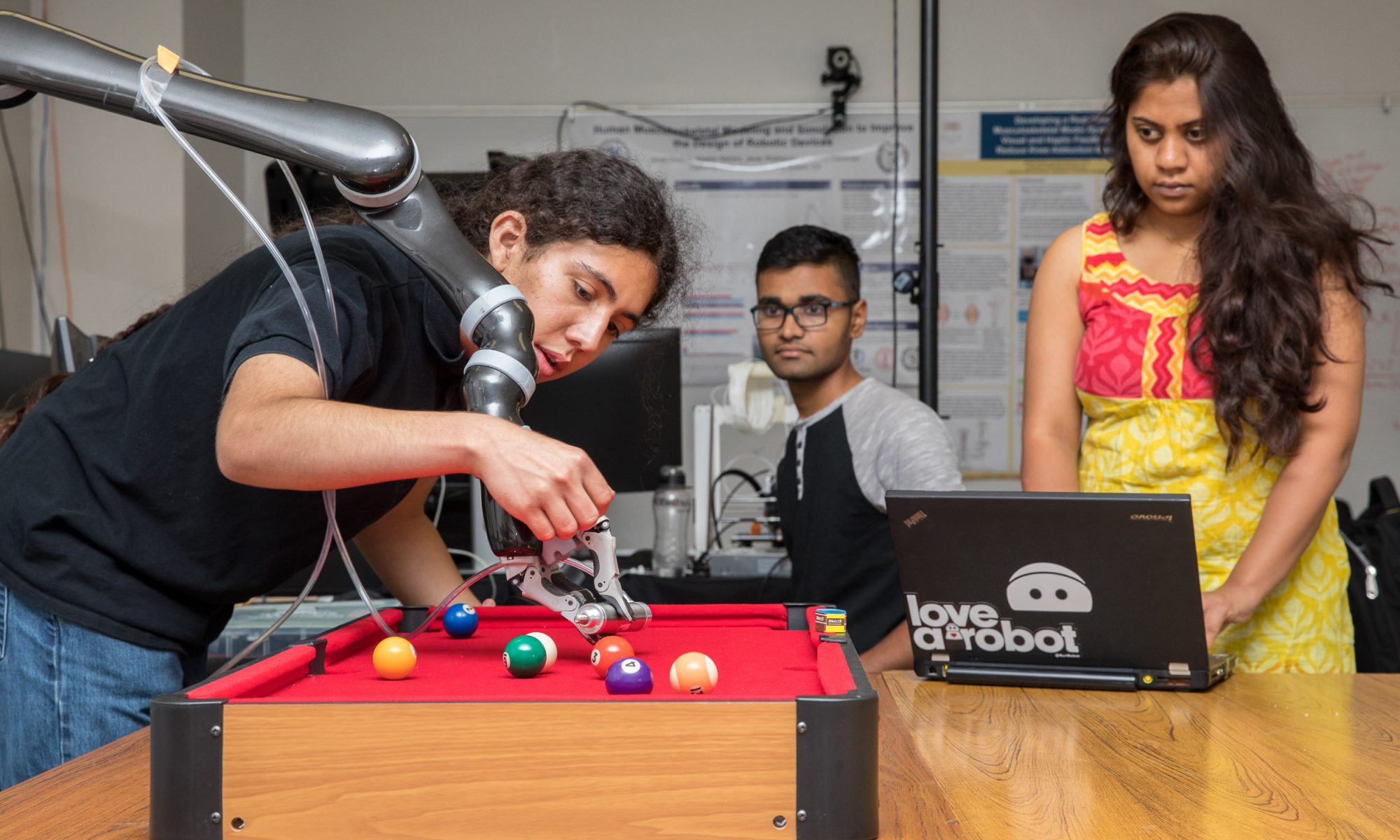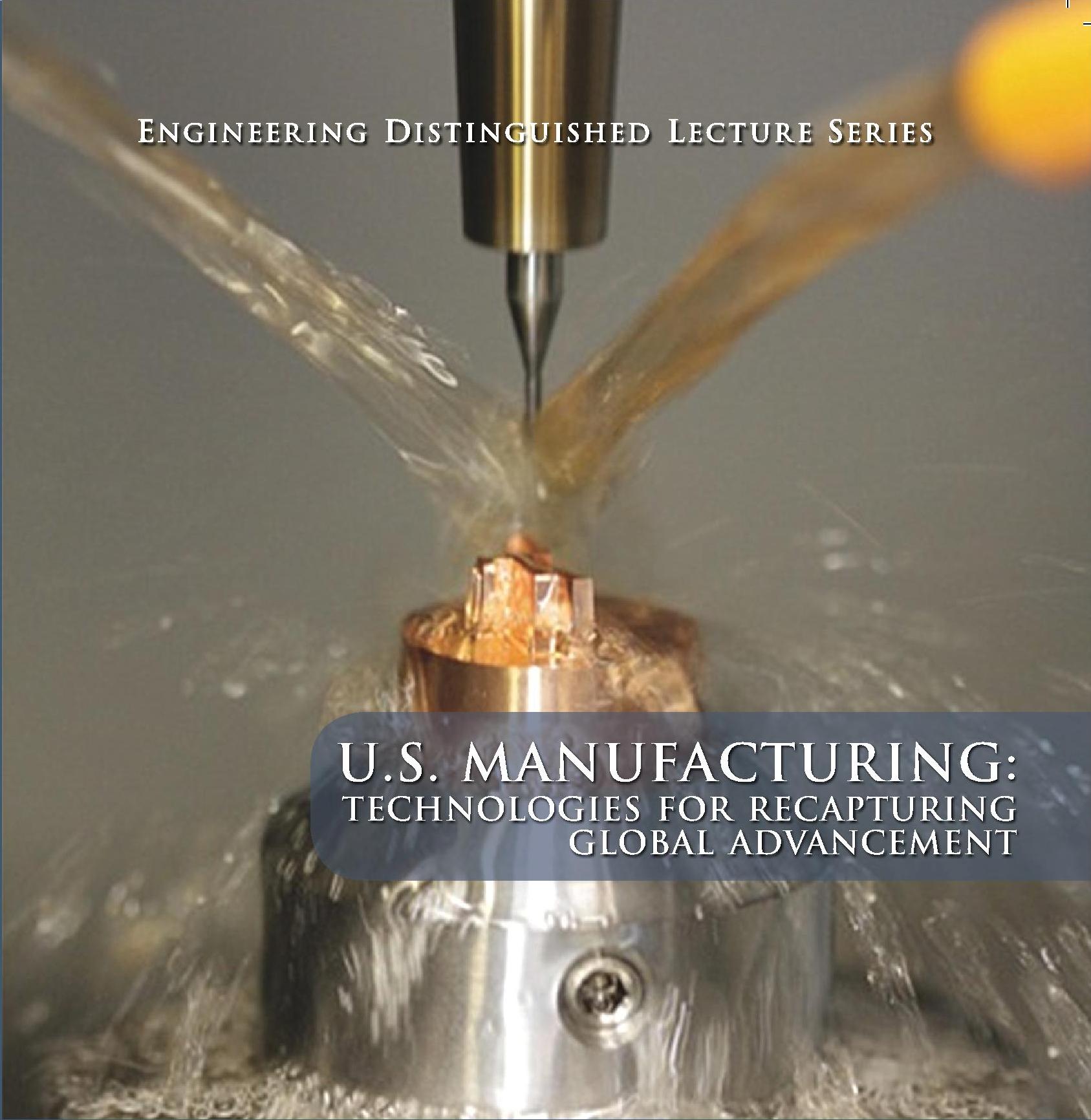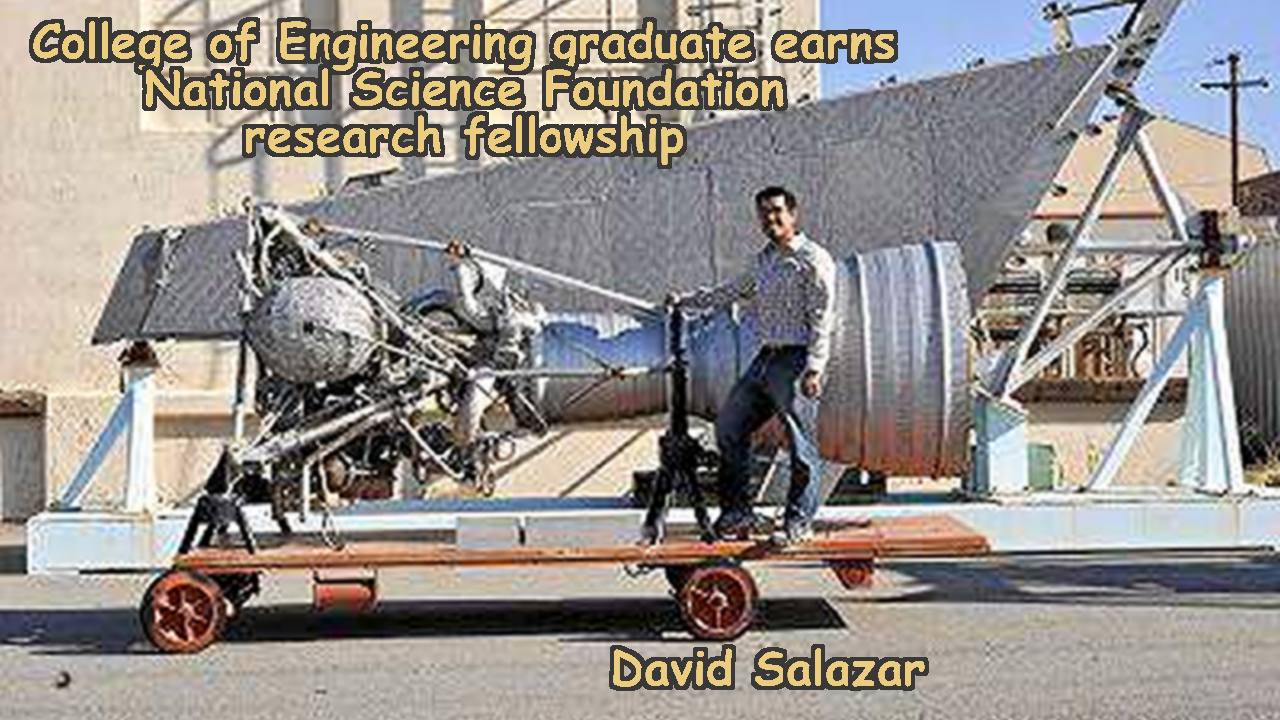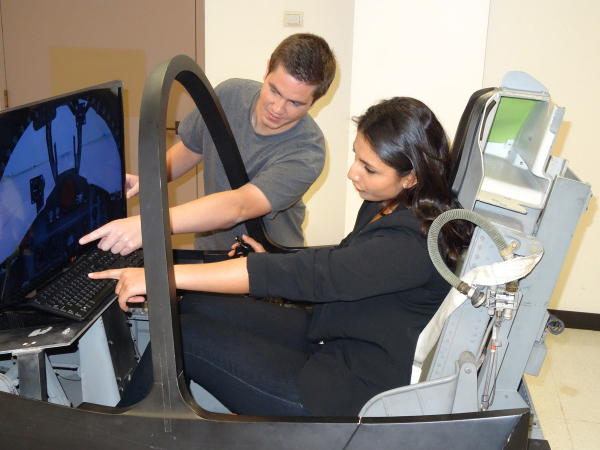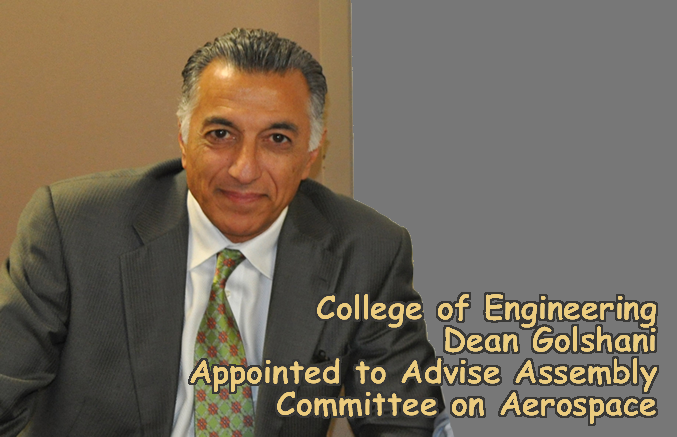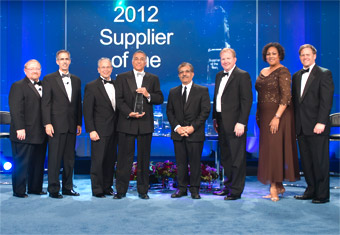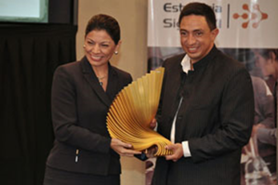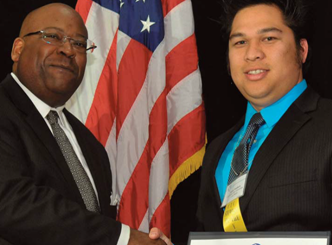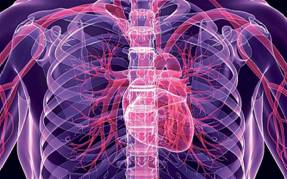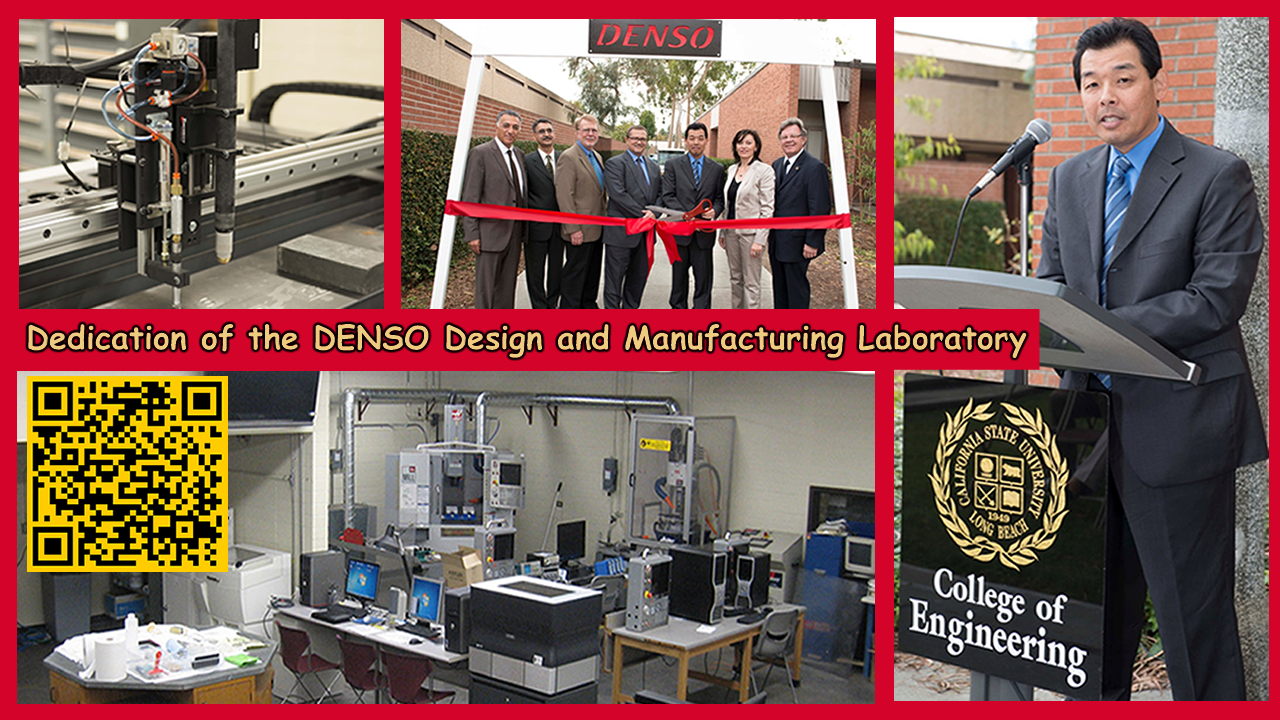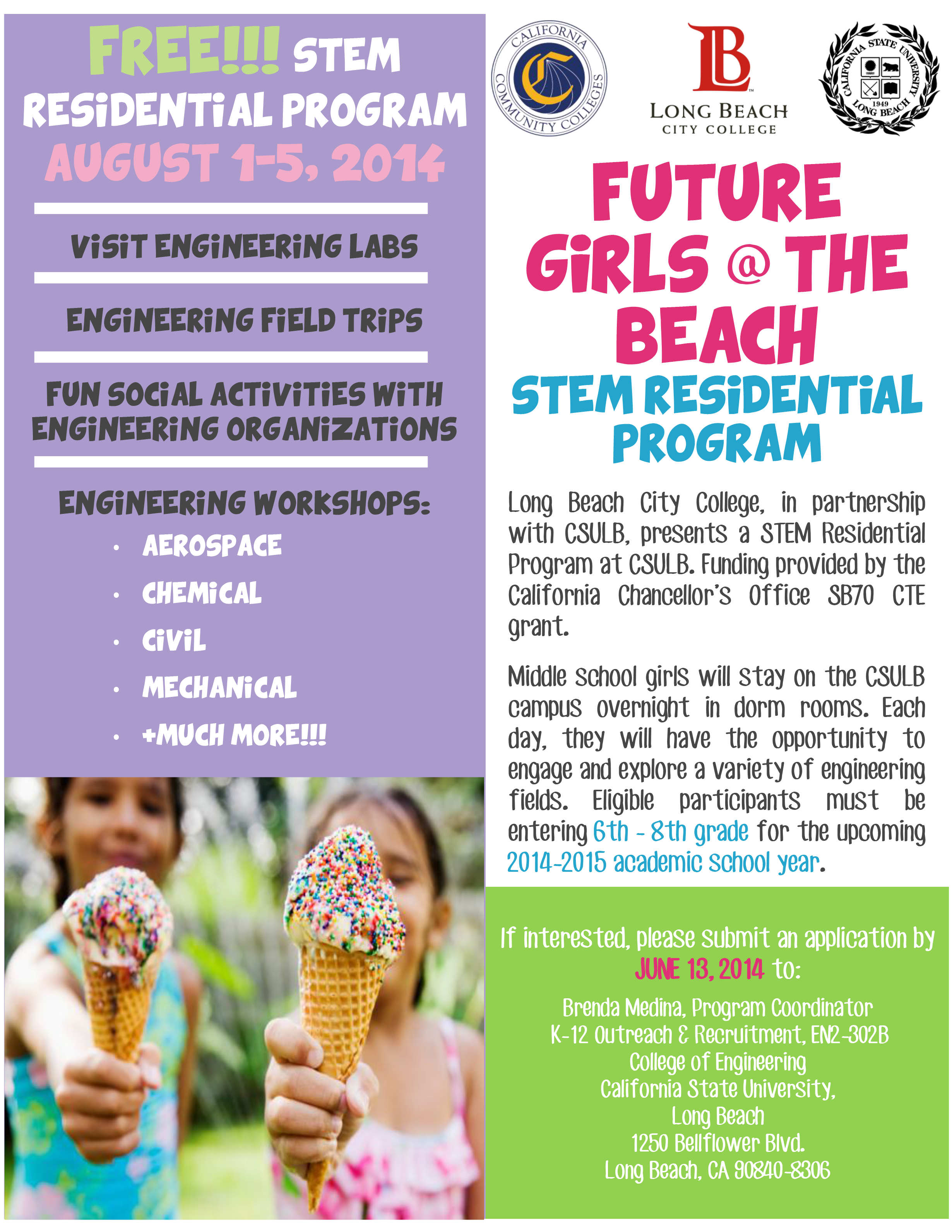Did you know that if the top 500 U.S.-based manufacturing companies were counted as an independent nation, their total revenue would rank them as the third largest economy in the world! Yet, the US manufacturing sector has experienced substantial job losses at an alarming rate over the past two decades. Since the historical peak in the late 1970s, fewer and fewer jobs have been created in the manufacturing sector. In fact employment in manufacturing is now at its lowest since 1950.
CSULB Grad Earns NSF Fellowship
Long Beach Press Telegram
There were two moments in David Salazar’s life when he knew he wanted to be an engineer, including the time when a ball of vomit floated toward him.
More on that later.
Salazar, a 28-year-old native of Orange, graduated Cal State Long Beach in December with a bachelor’s degree in mechanical engineering and recently earned a National Science Foundation Graduate Research Fellowship that will pay him $32,000 a year for three years while he furthers his studies at Stanford University.
… read more at Long Beach Press Telegram – CSULB graduate earns National Science Foundation research fellowship
COE Working with Northrop Grumman on Cockpit Design
The future of cockpit design may be recast for tomorrow’s fighter pilot thanks to Northrop Grumman-sponsored research led by College of Engineering Dean Forouzan Golshani.
“There is a concept that cockpit design follows what was invented 50 years ago,” explained Golshani. “Generally, we have more sophisticated cockpits today but they really only have more knobs, gadgets and displays to work with. Our partners at Northrop Grumman think there is a better approach to designing cockpits for next generation fighters, including how our children play computer games.”
He explained that a cockpit is all about interaction with the environment and how information should be transmitted to the pilot.
“If you look at the way mission-oriented computer games are played, they control the same kind of things that a pilot does,” he said. “How much fuel do you have? How do you release a weapon or drop a package? Gameplayers deal with many constraints at any given time. They manage information in a way older generations never could. Looking at 2020 and beyond, it would be wise to design a cockpit for the future, not past, generation.”
The potential for the cockpit redesign is enormous. “This is a project that has the potential to take the combined team of Northrop Grumman and CSULB College of Engineering to a big funding agency like the Department of Defense,” Golshani said. “Northrop Grumman is very interested in making this their next contribution to aerospace, beginning with the first phase of preliminary studies.”
Student participation in the research will yield thesis topics for individual graduate students and senior projects for groups of students.
“They are engaged to perform research alongside faculty members,” said Golshani, who hopes to learn as much from his students as they do from the project. “I hope they take with them the experience of participation in a real-world project that they can see from the beginning. This is their chance to be part of a realistic project that looks to the future.”
One of the project’s most useful tools is a wheeled flight simulator based on the design of Northrop Grumman’s F-5A/B Freedom Fighter. “The instrumentation has been taken out but our research will depend on what we build around the cockpit,” he explained. “We will build a virtual cockpit. Everything has to be tested before we can say this can be part of our future cockpit. And once we are ready to build it, we will ask the question, where in the aircraft should it be?
“Who said the position of a cockpit should be fixed? Why not put it in the plane’s belly and let it come up like a submarine conning tower?” he said. “Whether the cockpit offers an actual view of the reality around it or not, that view is secondary to everything the pilot needs to do. We use this cockpit on wheels as a building block for the digital future. We want to examine the alternatives to the existing complex panels of instrumentation.”
Nothing is sacred when it comes to the new look. “Will this control be a button? Will it be a switch? What about when the pilot is flying in a smoke filled cockpit? If the pilot can’t see the switch or the button, what good are they?” he asked. “Between all the senses, we should be able to convey the information that we want. In many ways, the new design is influenced by assistive technology that is so sophisticated, it allows the blind to use a flight simulator. If a cockpit can be designed that accommodates a pilot who cannot see, it is certain that same cockpit will do a good job working with a pilot who can see.”
Golshani is pleased by the opportunity for the university.
“This is the kind of work that a progressive College of Engineering ought to be doing,” he said. “I’m very proud of the faculty members, particularly those we have hired over the last few years. They come from the best institutions and they are our greatest resources. I think we have an awesome team and I feel good about our chances of success.”
From: News @ The Beach – College of Engineering Working with Northrop Grumman on New Cockpit Design
Dean Golshani Appointed to Assembly Committee on Aerospace
News @ The Beach
California State University, Long Beach (CSULB) College of Engineering Dean Forouzan Golshani was appointed recently to advise the Assembly Select Committee on Aerospace chaired by Assemblyman Al Muratsuchi (D-Torrance).
“I am pleased to have Dr. Forouzan Golshani join the Aerospace Advisory Council. He brings a wealth of knowledge as Dean of the College of Engineering at California State University, Long Beach, and I look forward to working with him and the council to support California’s aerospace industry,” said Muratsuchi.
As a member of the aerospace advisory committee, Goshani said he hopes he can help to bridge the gap between academic research and the types of policies enacted by policy makers.
“It’s an honor,” said Golshani. “It’s a great opportunity to offer input into things that matter. I have been specifically cognizant of the divide between technology and policy areas. The more Californians who are aware of technology, the more who will be better able to assess things from a modern technological perspective. I’m particularly pleased to be called upon to be a part of this committee.”
Golshani also believes he can make the biggest contribution to the issue of aerospace manufacturing revival.
“Manufacturing revival has diminished during the past two decades,” he said. “That is very unfortunate because, when you look at what made Southern California what it is, and at the iconic images of Southern California, they were from aerospace. Several things that many people identify Southern California with have their roots in the aerospace sector. We have seen a rapid erosion of this industry in Southern California. Boeing has downsized and Northrop has consolidated. The ability of this state to be the powerhouse of the nation has diminished. I hope we can help maintain this state’s supplier base to the local aerospace industry. That is still a huge advantage for the state’s economy.”
The meetings usually take place in the South Bay area and the next advisory committee meeting is anticipated to be sometime this month. Other committee members represent a wide range of organizations including including well-known aerospace companies like Boeing, Northrup Grumman and Lockheed Martin.
Advising an Assembly Select Committee will be a new experience for Golshani. “I have not participated directly to such an extent in the legislative process. Although I’ve been on multiple delegations that traveled to Washington D.C. to talk with members of Congress,” he said. “My interactions with this committee of experts will enable us to align our academic and educational objectives with the state’s highest needs. I don’t see my role as that of an advocate specifically for just the university. The advisory committee must make sound recommendations for all the region. Generally, I see this committee as an advisory committee to bridge the area of technology with the area of setting policy. That is a powerful mix. If there is an opportunity to help engineering colleges at CSUs and UCs, that is an added benefit.”
Golshani works closely with his college’s Dean’s Advisory Council–a group of more than 20 senior executives from the regional high-technology companies. “My work with our local industries has helped to inform me about the special committee’s goal,” he said. “Our advisory council comes together three times a year. We go over what matters to the industry and what affects CSULB and the College of Engineering. That is a great basis for formulating my advice to the members of the California Assembly about technology in general and specifically aerospace technology.”
As College of Engineering dean, Golshani has gained a clear perspective on Southern California’s aerospace industry.
“As I study the reasons for the erosion of the aerospace industry in Southern California, a number of factors come to light,” he explained. “Many of these reasons are related to Sacramento directly or indirectly. They include, for example, antiquated laws, including some environmental regulations. Too often, outdated laws remain on the books and they cause confusion and extra work for government and business because compliance becomes a much more difficult task when there is no clarity to the laws.
“In addition, many industries who leave California move to right-to-work states,” he added. “I hope to look at how to create a more level legal playing ground to help businesses stay in California. At the very least, we must work to see that outdated laws are not the reason businesses move out of the state. Another area that would be good to look at are the incentives provided to businesses extensively by other states. It is a matter of calculating dollars and cents to see what tax benefits would be lost if a business that generates employment moved out of the state. There are things I and the rest of the advisory committee can analyze on behalf of the Legislature to inform them about how we might be able to make the state of California more competitive.”
Golshani came to CSULB from London’s Imperial College, Wright State University and Arizona State University. He earned his bachelor’s degree in industrial engineering from the Arya Mehr University of Technology in Iran, his Master of Science degree in engineering systems in 1979 and his Ph.D. in computer science in 1982, both from Warwick University.
Golshani believes his appointment demonstrates the seriousness with which the state considers the aerospace industry.
“The issue of aerospace manufacturing is huge,” he said. “The White House takes it seriously enough to offer a $1.3 billion federal funding to Southern California this month through a research center at USC which will benefit many partnering agencies across the region. Everything indicates this is timely and that it is important for us to be strategizing collectively how we can put this state on the right track.”
COE Receives Boeing’s Supplier of the Year Award
PHOTO COURTESY OF BOEING CO
The College of Engineering was recently presented with Boeing’s “Supplier of the Year” award for providing exceptional performance and contributions to Boeing’s overall success. The COE, along with 16 companies, received the award during a ceremony held at the San Diego Convention Center.
The selection of the COE was on the basis of a longstanding relationship that included a consistently superior pipeline of talent, many successful collaborative projects, and partnership on research and development efforts. “These partners have gone above and beyond the call to help Boeing provide the best, most affordable products and services possible,” said Jack House, leader of Boeing Supplier Management.

The COE was honored in the category of “Academia” for its outstanding performance as a strategic university. “This award is a wonderful validation of our efforts to support regional socioeconomic development and to partner with Southern California business and industry,” says Forouzan Golshani, dean of the College of Engineering. “Our long and multifaceted relationship with Boeing has included numerous research and development projects, educational initiatives, student scholarships and support, and the Boeing Endowed Chair in Manufacturing—not to mention the fact that more than a few of their engineers have come from our program.”
At the Boeing Supplier of the Year Award ceremony were (l-r) Jack House, Boeing enterprise leader, Supplier Management; John Tracy, Boeing senior vice president and chief technology officer; Paul Pasquier, Boeing Engineering, Operations and Technology vice president, Supplier Management; CSULB Dean for the College of Engineering Forouzan Golshani; CSULB Associate Dean for the College of Engineering Hamid Rahai; Stan Deal, Boeing Commercial Airplanes vice president, Supply Chain Management; Joan Robinson-Berry, Boeing Shared Services Group vice president, Supplier Management; and Kent Fisher, Boeing Commercial Airplanes vice president, Supplier Management.
Juan Chaves, Recipient of Costa Rica’s Highest Technology Honors
By Todd Howard
Juan Chaves (MS in Electrical Engineering, 2009) is the recipient of Costa Rica’s two highest technology honors—the Jorge Manuel Dengo Award from the organization Strategy XXI Century, and the Clodomiro Picado Twight Technology Award from the Ministry of Science and Technology. He was presented with both awards by Costa Rican President Laura Chinchilla.
Chaves serves as the director of the Nanotechnology Laboratory at the Instituto Technologico de Costa Rica, which is the nation’s leading university of engineering and science. His laboratory is the most advanced and well-funded nanotechnology laboratory in Latin America, and he is regarded as a leading authority in this immense multidisciplinary field.
Nanotechnology, with its dizzying range of potential applications, is poised to change the world significantly in the coming decades. From steel that is hundreds of times stronger and lighter than that of today, to microscopic-sized circuit boards with processing speeds beyond our wildest imaginings, to cures for scores of illnesses—the race is on to bring the near limitless possibilities of nanotechnology to fruition in the twenty-first century.
Chaves received his country’s top technology honors for the groundbreaking graduate research that he conducted at CSULB in the use of carbon “nanotubes” as an alternative to pharmaceutical antibiotics for stopping bacterial infections. This graduate research project, which was supervised by Chaves’ graduate advisor, Dr. Tulin Mangir, began as an exploration into electrical engineering applications of nanomaterials, but Chaves was inspired to move into the arena of biomedical applications after witnessing an unexpected phenomenon in the laboratory.
“I benefited from National Science Foundation funding to develop interconnections for computer devices using carbon nanotubes, and Dr. Mangir and I were using bacteria to clean these nanotubes,” says Chaves. “I saw the bacteria reacting to the nanotubes in some very intriguing ways, and it became evident to me that nanomaterials could serve as highly effective antibiotics that function through mechanical rather than chemical means.”
Such nanotechnology innovations were first theorized in the late 1950s by Nobel Prize-winning physicist Richard Feynman. He described a process in which scientists would one day be able to manipulate the individual atoms and molecules of virtually any material, and that by so doing they could imbue these materials with exponentially enhanced strength, electrical conductivity, etc. It wasn’t until the 1980s that specialized microscopes would be developed that would enable researchers to begin to view materials at the “nanoscale” (a sheet of newspaper is about 100,000 nanometers thick), and it has taken another quarter century for innovations such as Chaves’ to begin to emerge.
It is now evident that nanotechnology’s potential for impacting a nation’s economy will soon be on par with that of the Industrial Revolution or the Information Age. In 2003, the National Science Foundation predicted that nanotechnology would become a trillion-dollar industry within the next two decades. In response, Congress has enacted legislation that seeks to ensure U.S. leadership in this industry by requiring all federal agencies to strategically coordinate their nanotechnology research. Other highly industrialized nations are taking similar measures in an effort to stake out their shares of the global marketplace.

However, nanotechnology is also providing enormous opportunities to developing nations, as evidenced by the fact that Chaves’ work at the Instituto Technologico is positioning Costa Rica as a major exporter of this technology. “We’re seizing this opportunity to shape the future rather than waiting for others to create it and export it to Costa Rica,” says Chaves. “We’re developing nanotechnologies in niches that other countries aren’t actively exploring yet—particularly in agriculture. Costa Rica is an agricultural country, and we are well-positioned for developing technology that adds value to our own agricultural products on the international market and for licensing this technology to other countries as well.”
Award-Winning Ph.D. Student Jeremy Bonifacio’s Healthy Ambition
By Todd Howard
Engineering Ph.D. student Jeremy Bonifacio is distinguishing himself on the national stage as an innovator of high-tech solutions to longstanding environmental and public-health issues. Last year, he traveled to the Transportation Research Board’s annual conference in Washington D.C. to receive the METRANS Transportation Center’s “Student of the Year” award as well as a certificate of commendation from the U.S. Department of Transportation for his academic excellence and research in the reduction of airborne pollution.
A student in the “Engineering and Industrial Applied Math” doctoral program that is a joint endeavor between the College of Engineering and Claremont Graduate University, Bonifacio’s research in Fluid Dynamics is creating technologies that disperse indoor and outdoor pollutants before they can reach dangerously high levels of concentrations, as well as biomedical instruments for treating pollution-related illnesses. “The number of people who are getting sick from airborne pollutants is on the rise in developed and developing nations alike,” says Bonifacio. “There is urgent need for a comprehensive range of solutions.” Bonifacio recently served as the student team leader on a $1.8 million joint research endeavor between CSULB and the Port of Los Angeles that developed “seawater scrubber” technology for reducing the high concentrations of diesel particulate matter that are emitted from oceangoing vessels. The project’s principle investigator was Dr. Hamid Rahai, Bonifacio’s PhD advisor.
In addition to his research in Fluid Dynamics, Bonifacio is developing biomedical technology that holds the promise of providing more accurate diagnoses and targeted treatment of pollution-related illnesses such as respiratory infections, heart disease, and lung cancer. He presently teaches Aerodynamics Laboratory classes in CSULB’s Department of Mechanical and Aerospace Engineering, and is preparing for a career as a consultant in the field of environmental pollutants and as an entrepreneur in the field of biomedical technologies.
Engineering for the Body: Reproducing Body Functions
Human biologists, computer scientists and engineers are teaming to advance neuroscience toward achieving yet another one of NAE’s Grand Challenges, namely, understanding the complex network we call brain. Modern noninvasive methods can simultaneously measure the activity of many brain cells. Comprehension of how the brain works will enable engineers to simulate its activities, leading to deeper insights about how and why the brain works and fails.
Dedication of the DENSO Design and Manufacturing Laboratory
Recognizing the DENSO Corporation’s continuous and generous support of the College of Engineering, officials at CSULB dedicated the newly named DENSO Design and Manufacturing Laboratory in a ribbon-cutting ceremony on Nov. 15, 2013. DENSO is a leading global supplier of advanced automotive technology, systems and components in the areas of thermal, powertrain control, electronics and information and safety, and its ongoing support has been instrumental in defining the college’s presence in the area of design and manufacturing.
“The College of Engineering wants to educate the best, most highly qualified students who will enter the work force and be able to immediately support the mission of their employers,” says Forouzan Golshani, Dean of the College of Engineering. “DENSO has been phenomenal in enabling us to educate students on modern equipment and up-to-date technology.”
CSULB Interim President Donald Para was also on hand to comment on Denso’s substantial support of the College of Engineering. “The mission of Cal State Long Beach centers on student success. We graduate students who are well-prepared for their chosen careers. For this campus to continue to realize this goal, we need corporate and community partners who provide a critical edge in our student’s education. We are honored and very grateful that DENSO continues to be a significant partner for the College of Engineering in providing a high quality education for our students.”
Through the DENSO Foundation, the company donates between $25,000 and $50,000 annually in support of the College of Engineering’s student activities, its lecture series, its Innovation Challenge competition, and other essential endeavors. The newly named lab provides students with a place to learn computer-aided design, manufacturing and non-destructive testing, as well as such cutting-edge fields as additive manufacturing, which involves making three-dimensional solid objects of virtually any shape from a digital model.
“In addition to enabling our students to acquire individual design and manufacturing skills, the DENSO Lab gives them the opportunity to learn to set up economical and efficient manufacturing processes, and this holds important implications for our region’s manufacturing industry and economy,” says Golshani. “There is a push by the federal government to bring manufacturing back to the US, and this lab is enabling us to produce engineers who can help restore our manufacturing sector to its former glory.”
Future Girls @ The Beach: STEM Residential Program
By Engineering Students Success Center
… read more; Future Girls @ The Beach: STEM Residential Program
